Attached files
| file | filename |
|---|---|
| 8-K - FORM 8-K - US FOODS, INC. | d184795d8k.htm |

Q1 2016 US Foods, Inc. Performance Update A Taste of What’s Cooking at US Foods May 2016 Exhibit 99.1

This presentation and related comments by our management contains “forward-looking statements” within the meaning of the federal securities laws. Forward-looking statements include information concerning our liquidity and our possible or assumed future results of operations, including descriptions of our business strategies. These statements often include words such as “believe,” “expect,” “project,” “anticipate,” “intend,” “plan,” “estimate,” “target,” “seek,” “will,” “may,” “would,” “should,” “could,” “forecasts,” “mission,” “strive,” “more,” “goal,” or similar expressions. The statements are based on assumptions that we have made, based on our experience in the industry as well as our perceptions of historical trends, current conditions, expected future developments, and other factors we think are appropriate. We believe these judgments are reasonable. However, you should understand that these statements are not guarantees of performance or results. Our actual results could differ materially from those expressed in the forward-looking statements. There are a number of risks, uncertainties, and other important factors, many of which are beyond our control, that could cause our actual results to differ materially from the forward-looking statements contained in this presentation. Such risks, uncertainties, and other important factors include, among others: our ability to remain profitable during times of cost inflation, commodity volatility, and other factors; industry competition and our ability to successfully compete; our reliance on third-party suppliers, including the impact of any interruption of supplies or increases in product costs; risks related to our indebtedness, including our substantial amount of debt, our ability to incur substantially more debt, and increases in interest rates; any change in our relationships with GPOs; any change in our relationships with long-term customers; our ability to increase sales to independent customers; our ability to successfully consummate and integrate future acquisitions; our ability to achieve the benefits that we expect from our cost savings programs; shortages of fuel and increases or volatility in fuel costs; any declines in the consumption of food prepared away from home, including as a result of changes in the economy or other factors affecting consumer confidence; liability claims related to products we distribute; our ability to maintain a good reputation; costs and risks associated with labor relations and the availability of qualified labor; changes in industry pricing practices; changes in competitors’ cost structures; our ability to retain customers not obligated by long-term contracts to continue purchasing products from us; environmental, health and safety costs; costs and risks associated with government laws and regulations, including environmental, health, safety, food safety, transportation, labor and employment, laws and regulations, and changes in existing laws or regulations; technology disruptions and our ability to implement new technologies; costs and risks associated with a potential cyber-security incident; our ability to manage future expenses and liabilities associated with our retirement benefits; disruptions to our business caused by extreme weather conditions; costs and risks associated with litigation; changes in consumer eating habits; costs and risks associated with our intellectual property protections; and risks associated with potential infringements of the intellectual property of others. Additional information regarding these factors is contained in our filings with the Securities Exchange Commission. All forward-looking statements made in this presentation are qualified by these cautionary statements. The forward looking statements contained in this presentation speak only as of the date of this presentation. We undertake no obligation, other than as may be required by law, to update or revise any forward-looking or cautionary statements to reflect changes in assumptions, the occurrence of events, unanticipated or otherwise, or changes in future operating results over time or otherwise. Comparisons of results between current and prior periods are not intended to express any future trends, or indications of future performance, unless expressed as such, and should only be viewed as historical data. Forward-Looking Statements Notice
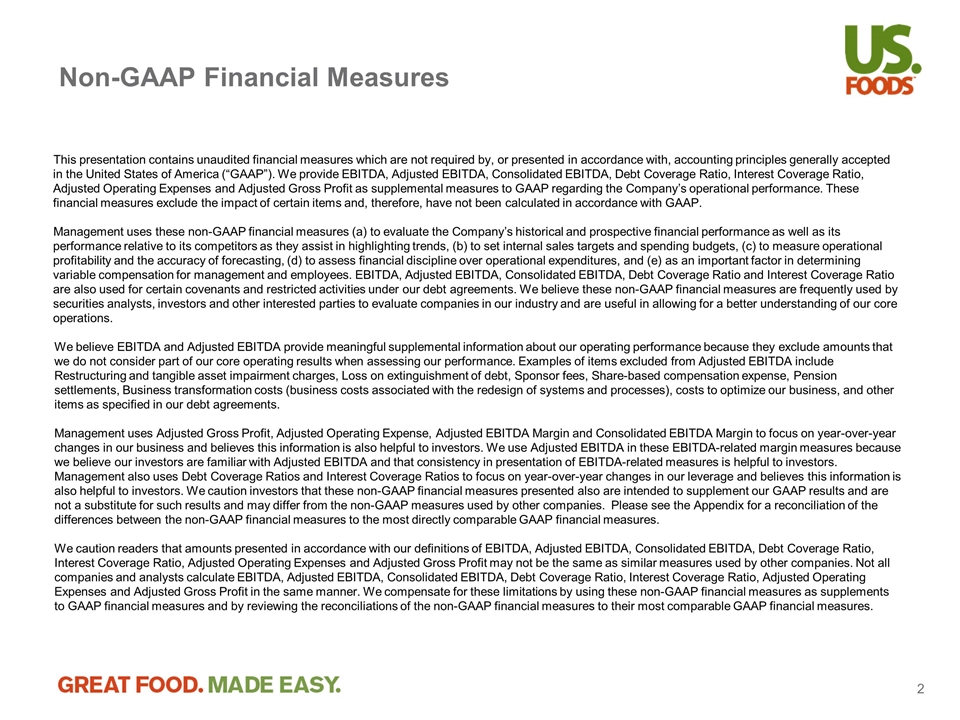
This presentation contains unaudited financial measures which are not required by, or presented in accordance with, accounting principles generally accepted in the United States of America (“GAAP”). We provide EBITDA, Adjusted EBITDA, Consolidated EBITDA, Debt Coverage Ratio, Interest Coverage Ratio, Adjusted Operating Expenses and Adjusted Gross Profit as supplemental measures to GAAP regarding the Company’s operational performance. These financial measures exclude the impact of certain items and, therefore, have not been calculated in accordance with GAAP. Management uses these non-GAAP financial measures (a) to evaluate the Company’s historical and prospective financial performance as well as its performance relative to its competitors as they assist in highlighting trends, (b) to set internal sales targets and spending budgets, (c) to measure operational profitability and the accuracy of forecasting, (d) to assess financial discipline over operational expenditures, and (e) as an important factor in determining variable compensation for management and employees. EBITDA, Adjusted EBITDA, Consolidated EBITDA, Debt Coverage Ratio and Interest Coverage Ratio are also used for certain covenants and restricted activities under our debt agreements. We believe these non-GAAP financial measures are frequently used by securities analysts, investors and other interested parties to evaluate companies in our industry and are useful in allowing for a better understanding of our core operations. We believe EBITDA and Adjusted EBITDA provide meaningful supplemental information about our operating performance because they exclude amounts that we do not consider part of our core operating results when assessing our performance. Examples of items excluded from Adjusted EBITDA include Restructuring and tangible asset impairment charges, Loss on extinguishment of debt, Sponsor fees, Share-based compensation expense, Pension settlements, Business transformation costs (business costs associated with the redesign of systems and processes), costs to optimize our business, and other items as specified in our debt agreements. Management uses Adjusted Gross Profit, Adjusted Operating Expense, Adjusted EBITDA Margin and Consolidated EBITDA Margin to focus on year-over-year changes in our business and believes this information is also helpful to investors. We use Adjusted EBITDA in these EBITDA-related margin measures because we believe our investors are familiar with Adjusted EBITDA and that consistency in presentation of EBITDA-related measures is helpful to investors. Management also uses Debt Coverage Ratios and Interest Coverage Ratios to focus on year-over-year changes in our leverage and believes this information is also helpful to investors. We caution investors that these non-GAAP financial measures presented also are intended to supplement our GAAP results and are not a substitute for such results and may differ from the non-GAAP measures used by other companies. Please see the Appendix for a reconciliation of the differences between the non-GAAP financial measures to the most directly comparable GAAP financial measures. We caution readers that amounts presented in accordance with our definitions of EBITDA, Adjusted EBITDA, Consolidated EBITDA, Debt Coverage Ratio, Interest Coverage Ratio, Adjusted Operating Expenses and Adjusted Gross Profit may not be the same as similar measures used by other companies. Not all companies and analysts calculate EBITDA, Adjusted EBITDA, Consolidated EBITDA, Debt Coverage Ratio, Interest Coverage Ratio, Adjusted Operating Expenses and Adjusted Gross Profit in the same manner. We compensate for these limitations by using these non-GAAP financial measures as supplements to GAAP financial measures and by reviewing the reconciliations of the non-GAAP financial measures to their most comparable GAAP financial measures. Non-GAAP Financial Measures
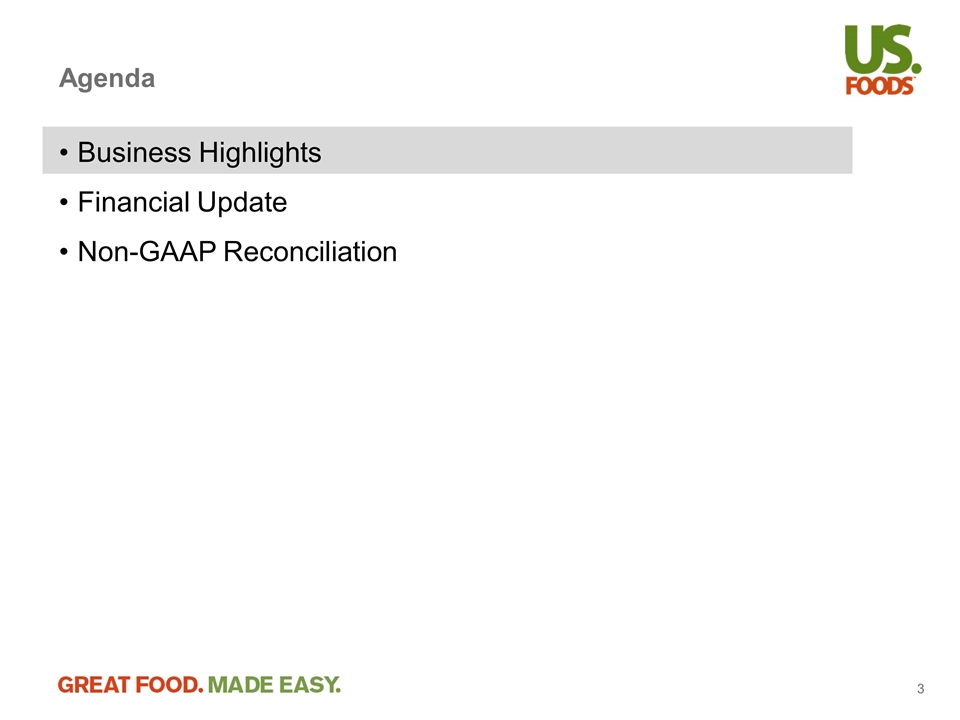
Agenda Business Highlights Financial Update Non-GAAP Reconciliation

Business Highlights Q1 Performance Highlights Organic volume and sales results Case volume increased 1.8% due to strong performance in independent restaurants Net sales increased 0.1% Volume and sales results, including acquisitions Case volume increased 2.4% Net sales increased 0.7% Adjusted EBITDA was $203 million1, a $44 million improvement compared with prior year Net Income was $14 million, a $7 million improvement compared with prior year Business Highlights Continued focus on strategy of Great Food. Made Easy. Continued strength in independent restaurant customer case volume growth Roll-out of new field structure progressing well Investing over $50 million for expansion of our Seattle, Washington and Fort Mill, South Carolina facilities to support growth Continued integration and completion of acquisitions Note:(1) Reconciliation of this non-GAAP measure is provided in the Appendix.
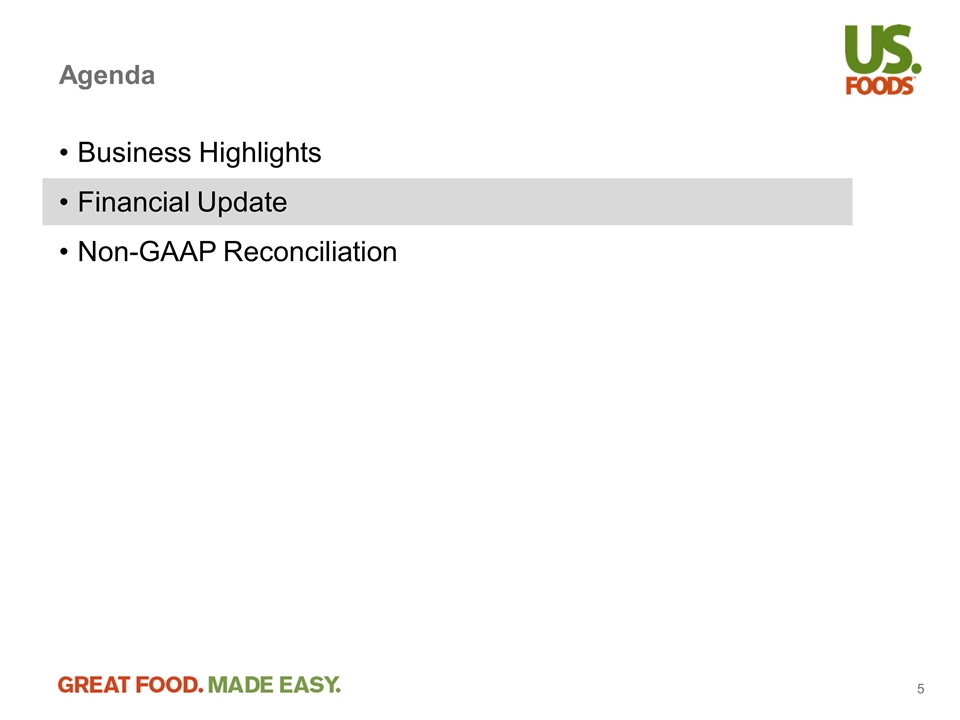
Agenda Business Highlights Financial Update Non-GAAP Reconciliation
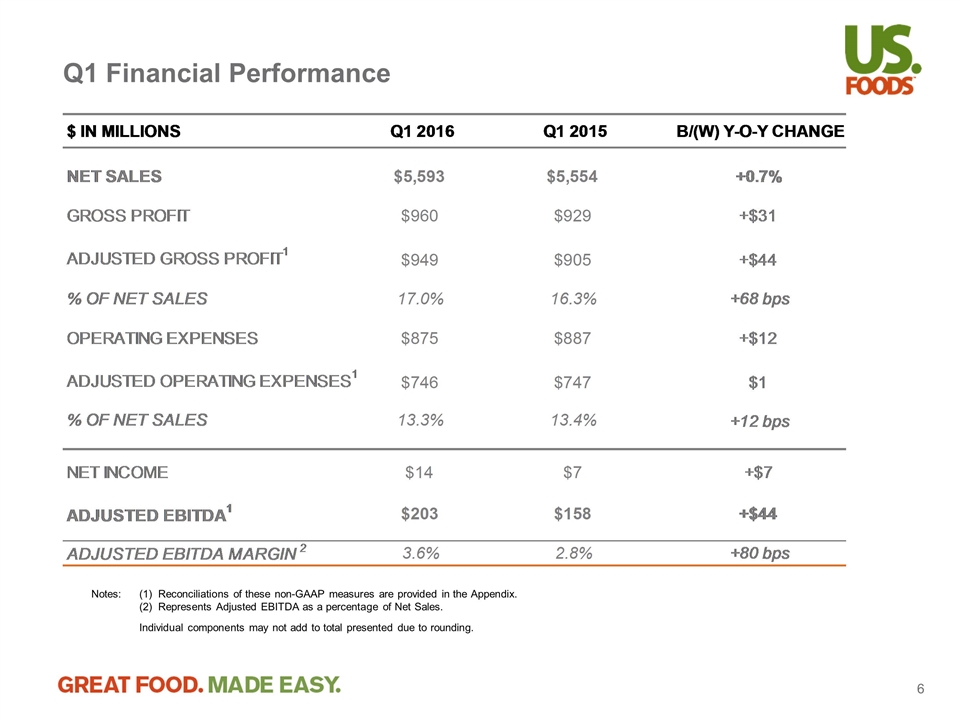
Q1 Financial Performance Notes: (1) Reconciliations of these non-GAAP measures are provided in the Appendix. (2) Represents Adjusted EBITDA as a percentage of Net Sales. Individual components may not add to total presented due to rounding.
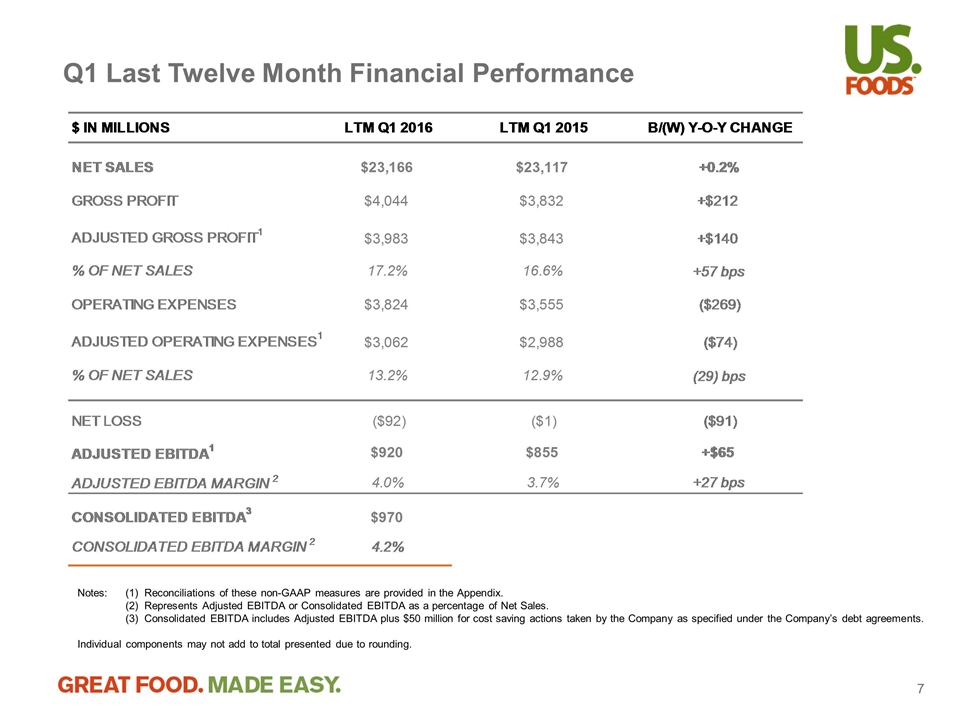
Notes:(1) Reconciliations of these non-GAAP measures are provided in the Appendix. (2) Represents Adjusted EBITDA or Consolidated EBITDA as a percentage of Net Sales. (3) Consolidated EBITDA includes Adjusted EBITDA plus $50 million for cost saving actions taken by the Company as specified under the Company’s debt agreements. Individual components may not add to total presented due to rounding. Q1 Last Twelve Month Financial Performance
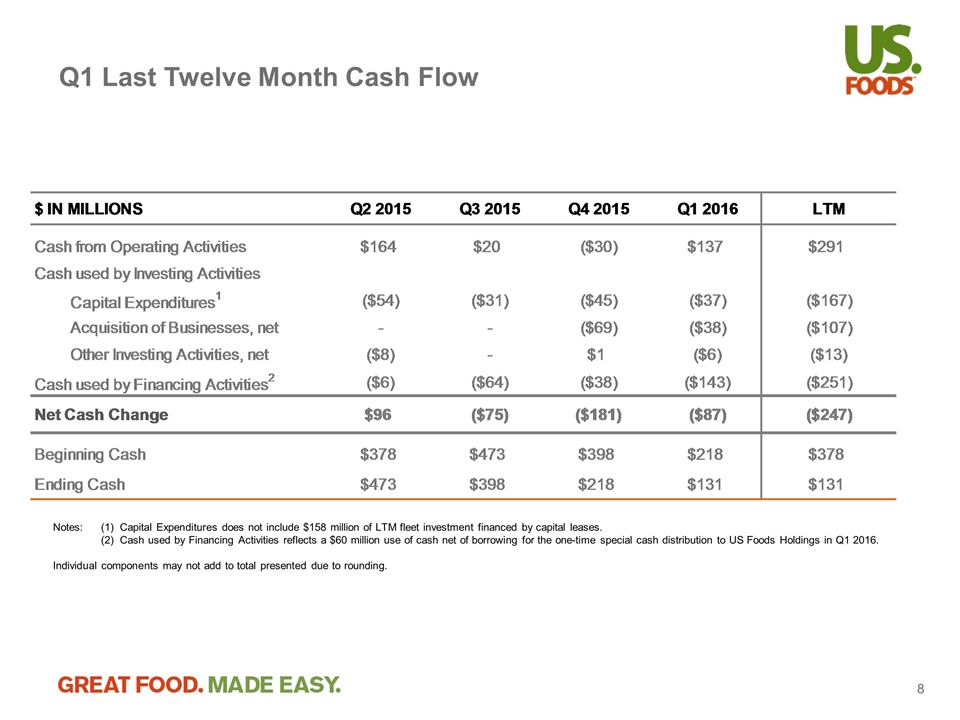
Q1 Last Twelve Month Cash Flow Notes:(1) Capital Expenditures does not include $158 million of LTM fleet investment financed by capital leases. (2) Cash used by Financing Activities reflects a $60 million use of cash net of borrowing for the one-time special cash distribution to US Foods Holdings in Q1 2016. Individual components may not add to total presented due to rounding.
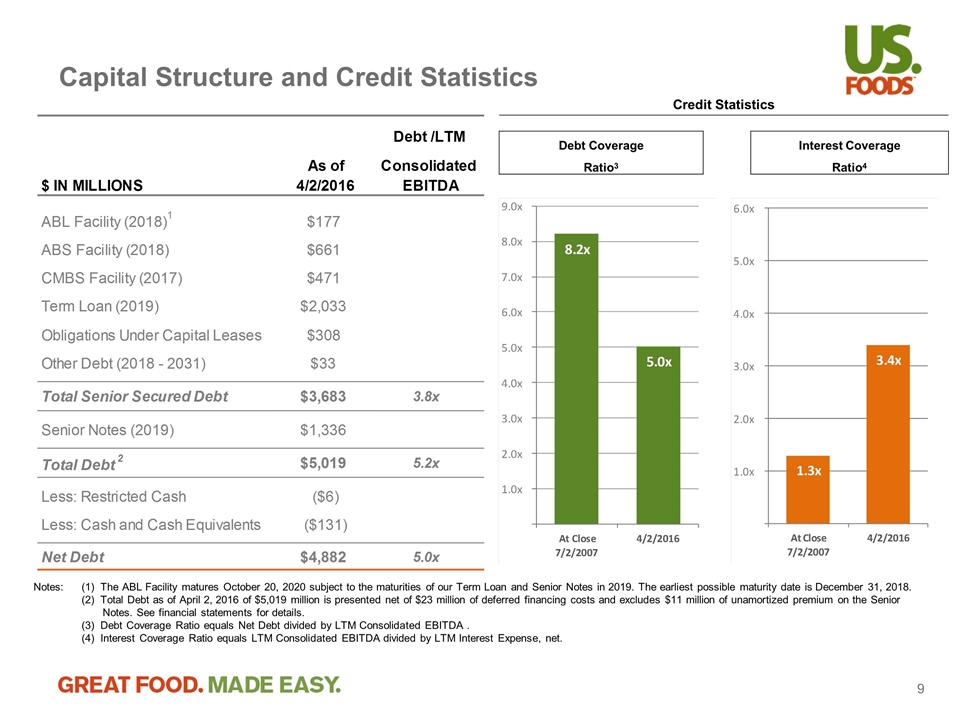
Notes:(1) The ABL Facility matures October 20, 2020 subject to the maturities of our Term Loan and Senior Notes in 2019. The earliest possible maturity date is December 31, 2018. (2) Total Debt as of April 2, 2016 of $5,019 million is presented net of $23 million of deferred financing costs and excludes $11 million of unamortized premium on the Senior Notes. See financial statements for details. (3) Debt Coverage Ratio equals Net Debt divided by LTM Consolidated EBITDA . (4) Interest Coverage Ratio equals LTM Consolidated EBITDA divided by LTM Interest Expense, net. Credit Statistics Debt Coverage Interest Coverage Ratio3 Ratio4 Capital Structure and Credit Statistics
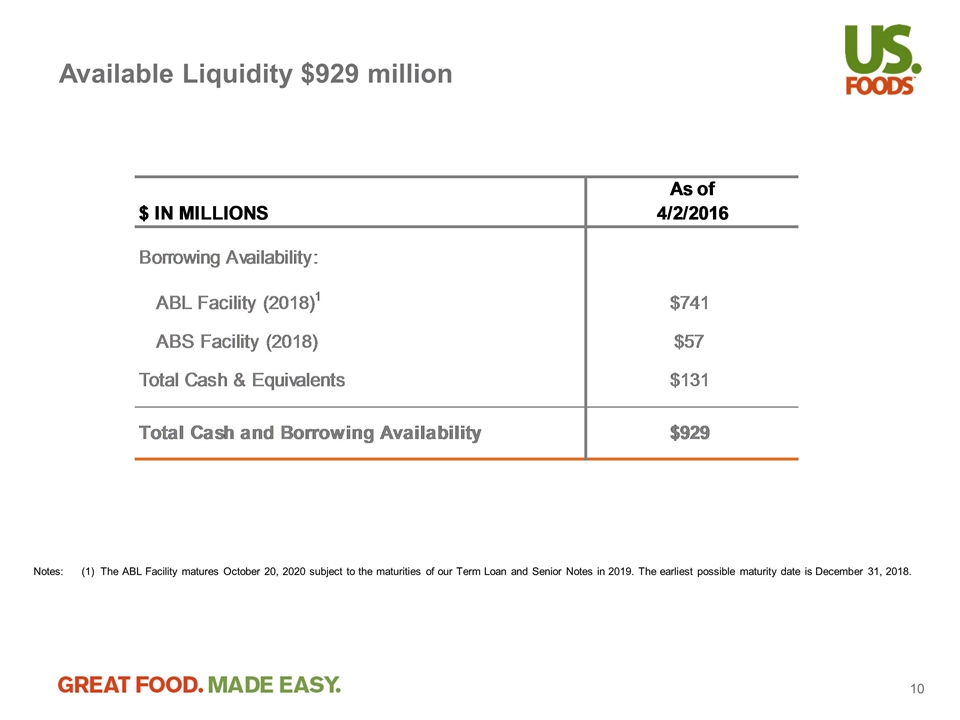
Available Liquidity $929 million Notes:(1) The ABL Facility matures October 20, 2020 subject to the maturities of our Term Loan and Senior Notes in 2019. The earliest possible maturity date is December 31, 2018.

Agenda Business Highlights Financial Update Non-GAAP Reconciliation
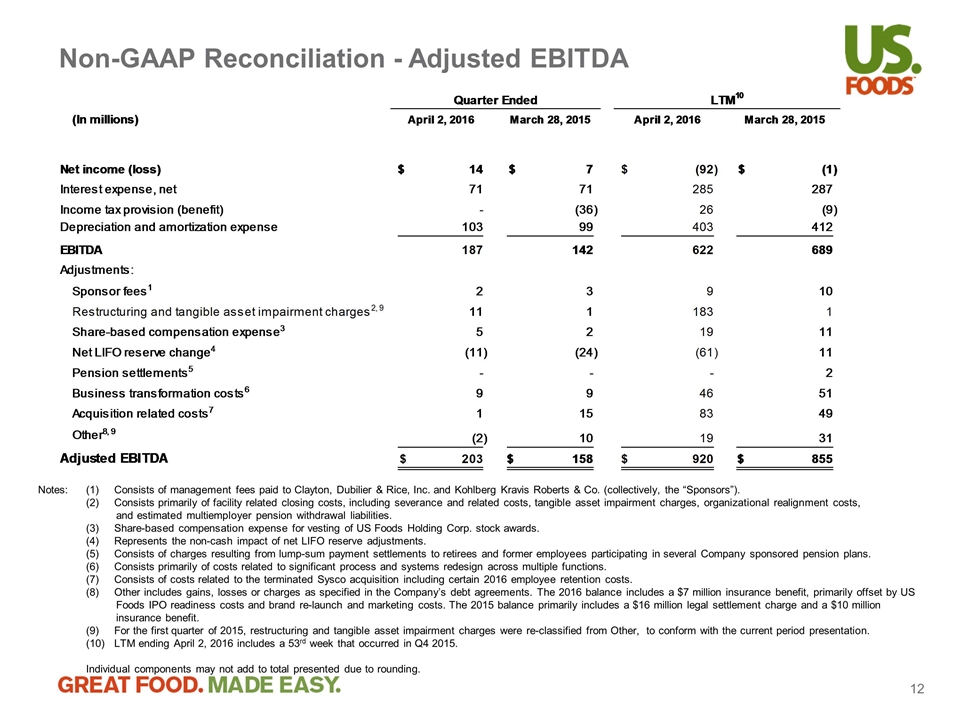
Non-GAAP Reconciliation - Adjusted EBITDA Notes:(1) Consists of management fees paid to Clayton, Dubilier & Rice, Inc. and Kohlberg Kravis Roberts & Co. (collectively, the “Sponsors”). (2) Consists primarily of facility related closing costs, including severance and related costs, tangible asset impairment charges, organizational realignment costs, and estimated multiemployer pension withdrawal liabilities. (3) Share-based compensation expense for vesting of US Foods Holding Corp. stock awards. (4) Represents the non-cash impact of net LIFO reserve adjustments. (5) Consists of charges resulting from lump-sum payment settlements to retirees and former employees participating in several Company sponsored pension plans. (6) Consists primarily of costs related to significant process and systems redesign across multiple functions. (7) Consists of costs related to the terminated Sysco acquisition including certain 2016 employee retention costs. (8) Other includes gains, losses or charges as specified in the Company’s debt agreements. The 2016 balance includes a $7 million insurance benefit, primarily offset by US Foods IPO readiness costs and brand re-launch and marketing costs. The 2015 balance primarily includes a $16 million legal settlement charge and a $10 million insurance benefit. (9) For the first quarter of 2015, restructuring and tangible asset impairment charges were re-classified from Other, to conform with the current period presentation. (10) LTM ending April 2, 2016 includes a 53rd week that occurred in Q4 2015. Individual components may not add to total presented due to rounding.
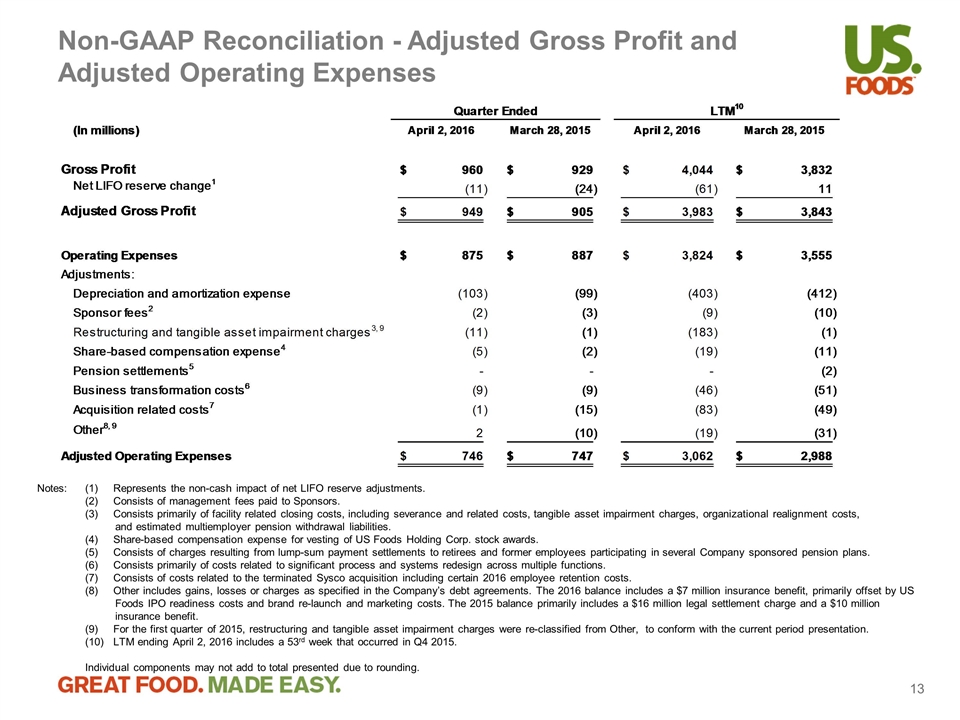
Non-GAAP Reconciliation - Adjusted Gross Profit and Adjusted Operating Expenses Notes:(1) Represents the non-cash impact of net LIFO reserve adjustments. (2) Consists of management fees paid to Sponsors. (3) Consists primarily of facility related closing costs, including severance and related costs, tangible asset impairment charges, organizational realignment costs, and estimated multiemployer pension withdrawal liabilities. (4) Share-based compensation expense for vesting of US Foods Holding Corp. stock awards. (5) Consists of charges resulting from lump-sum payment settlements to retirees and former employees participating in several Company sponsored pension plans. (6) Consists primarily of costs related to significant process and systems redesign across multiple functions. (7) Consists of costs related to the terminated Sysco acquisition including certain 2016 employee retention costs. (8) Other includes gains, losses or charges as specified in the Company’s debt agreements. The 2016 balance includes a $7 million insurance benefit, primarily offset by US Foods IPO readiness costs and brand re-launch and marketing costs. The 2015 balance primarily includes a $16 million legal settlement charge and a $10 million insurance benefit. (9) For the first quarter of 2015, restructuring and tangible asset impairment charges were re-classified from Other, to conform with the current period presentation. (10) LTM ending April 2, 2016 includes a 53rd week that occurred in Q4 2015. Individual components may not add to total presented due to rounding.

